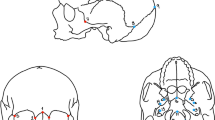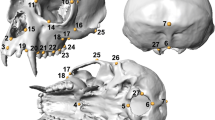Abstract
As both degree of masculinity/femininity in sexually dimorphic organisms and developmental instability are put forward as indicators of individual quality, they are expected to correlate positively. However, the results in the literature are equivocal. One reason may be that most research has been performed in populations exposed to relatively low levels of parasitism. This article studies associations between the degree of masculinity/femininity and the fluctuating asymmetry (a measure of developmental instability) of skulls of three primate species [baboon (Papio anubis), eastern lowland gorilla (Gorilla beringei graueri), and chimpanzee (Pan troglodytes)] collected in the wild. The exposure to infection and parasites is likely to be higher in these individuals compared to captive primates and humans, and therefore likely to increase the levels of association. While the degree of individual masculinity/femininity and levels of fluctuating asymmetry were quantified accurately, I found no evidence of an association between them. My results thus are in line with the conclusion of a recent meta-analysis, that there is little evidence for associations between masculinity/femininity and developmental instability.




Similar content being viewed by others
References
Bergman, T. J., Beehner, J. C., Cheney, D. L., & Seyfarth, R. M. (2003). Hierarchical classification by rank and kinship in baboons. Science, 302, 1234–1236.
Brown, W. M., Price, M. E., Kang, J. S., Pound, N., Zhou, Y., & Yu, H. (2008). Fluctuating asymmetry and preferences for sex-typical bodily characteristics. Proceedings of the National Academy of Sciences of the USA, 105, 12938–12943.
Cobb, S. N., & O’Higgins, P. (2007). The ontogeny of sexual dimorphism in the facial skeleton of the African apes. Journal of Human Evolution, 53, 176–190.
Darwin, C. (1859). On the origin of species. London: John Murray.
Fairbairn, D. J., & Blanckenhorn, W. U. (2007). Sex, size, and gender roles: Evolutionary studies of sexual size dimorphism. Oxford: Oxford University Press.
Gangestad, S. W., & Thornhill, R. (1999). Individual differences in developmental precision and fluctuating asymmetry: A model and its implications. Journal of Evolutionary Biology, 12, 402–416.
Gangestad, S. W., & Thornhill, R. (2003). Facial masculinity and fluctuating asymmetry. Evolution and Human Behavior, 24, 231–241.
Getty, T. (2002). Signaling health versus parasites. The American Naturalist, 159, 363–371.
Houle, D. (1997). Comment on “A meta-analysis of the heritability of developmental stability” by Moller and Thornhill. Journal of Evolutionary Biology, 10, 17–20.
Kanda, N., Tsuchida, T., & Tamaki, K. (1996). Testosterone inhibits immunoglobulin production by human peripheral blood mononuclear cells. Clinical and Experimental Immunology, 106, 410–415.
Klingenberg, C. P. (2003). A developmental perspective on developmental instability: Theory, models and mechanisms. In M. Polak (Ed.), Developmental instability: Causes and consequences (pp. 14–34). New York: Oxford University Press.
Klingenberg, C. P. (2011). MorphoJ: An integrated software package for geometric morphometrics. Molecular Ecology Resources, 11, 353–357.
Koehler, N., Simmons, L. W., Rhodes, G., & Peters, M. (2004). The relationship between sexual dimorphism in human faces and fluctuating asymmetry. Proceedings of the Royal Society of London B: Biological Sciences, 271, S233–S236.
Kokko, H., Brooks, R., McNamara, J. M., & Houston, A. I. (2002). The sexual selection continuum. Proceedings of the Royal Society of London B : Biological Sciences, 269, 1331–1340.
Leamy, L. (1984). Morphometric studies in inbred and hybrid house mice. V. Directional and fluctuating asymmetry. The American Naturalist, 123, 579–593.
Lefevre, C. E., Lewes, G. J., Perrett, D. I., & Penke, L. (2013). Telling facial metrics: Facial width is associated with testosterone levels in men. Evolution and Human Behavior, 34, 273–279.
Little, A. C., Jones, B. C., Waitt, C., Tiddeman, B. P., & Feinberg, D. R. (2008). Symmetry is related to sexual dimorphism in faces: Data across culture and species. PLoS One, 3, e2106.
Møller, A. P. (1992). Female swallow preference for symmetrical male sexual ornaments. Nature, 357, 238–240.
Møller, A. P., & Thornhill, R. (1997). A meta-analysis of the heritability of developmental stability. Journal of Evolutionary Biology, 10, 1–16.
Newton-Fisher, N. E. (2014). Roving females and patient males: A new perspective on the mating strategies of chimpanzees. Biological Reviews, 89, 356–374.
Palmer, A. R., & Strobeck, C. (1986). Fluctuating asymmetry: Measurement, analysis, patterns. Annual Review of Ecology and Systematics, 17, 391–421.
Palmer, A. R., & Strobeck, C. (1997). Fluctuating asymmetry and developmental stability: Heritability of observable variation vs. heritability of inferred cause. Journal of Evolutionary Biology, 10, 39–49.
Perrett, D. I., Lee, K. J., Penton-Voak, I., Rowland, D., Yoshikawa, S., Burt, D. M., Henzi, S. P., Castles, D. L., & Akamatsu, S. (1998). Effects of sexual dimorphism on facial attractiveness. Nature, 394, 884–887.
Polak, M. (2003). Developmental instability: Causes and consequences. Oxford: Oxford University Press.
Puts, D. A. (2010). Beauty and the beast: Mechanisms of sexual selection in humans. Evolution and Human Behavior, 31, 157–175.
Robbins, M. M. (2001). Variation in the social system of mountain gorillas: The male perspective. In M. M. Robbins, P. Sicotte, & K. J. Stewart (Eds.), Mountain gorillas: Three decades of research at Karisoke (pp. 29–58). Cambridge, U.K: Cambridge University Press.
Smuts, B. (1987). Sexual competition and mate choice. In B. Smuts, D. Cheney, R. Seyfarth, R. Wrangham, & T. Struhsaker (Eds.), Primate societies (pp. 385–399). Chicago: University of Chicago Press.
Van Dongen, S. (2009). A critical re-evaluation of the association between 2D:4D ratios and fluctuating asymmetry in humans. Annals of Human Biology, 36, 186–198.
Van Dongen, S. (2011). Associations between asymmetry and human attractiveness: Possible direct effects of asymmetry and signatures of publication bias. Annals of Human Biology, 38, 317–323.
Van Dongen, S. (2012). Fluctuating asymmetry and masculinity/femininity in humans: A meta-analysis. Archives of Sexual Behavior, 41, 1453–1460.
Van Dongen, S., & Forstmeier, W. (2012). Lack of genetic variation of developmental instability in zebra finch (Taeniopygia guttata) wing and tarsus. Evolutionary Ecology Research, 14, 285–298.
Van Dongen, S., & Gangestad, S. W. (2011). Human fluctuating asymmetry in relation to health and quality: A meta-analysis. Evolution and Human Behavior, 32, 380–398.
Verdonck, A., Gaethofs, M., Carels, C., & Zegher, F. (1999). Effect of low-dose testosterone treatment on craniofacial growth in boys with delayed puberty. European Journal of Orthodontics, 21, 137–143.
Yamagiwa, J., & Kahekwa, J. (2001). Dispersal patterns, group structure, and reproductive parameters of eastern lowland gorillas at Kahuzi in the absence of infanticide. In M. M. Robbins, P. Sicotte, & K. J. Stewart (Eds.), Mountain gorillas: Three decades of research at Karisoke (pp. 89–122). Cambridge, U.K.: Cambridge University Press.
Zahavi, A. (1975). Mate selection: A selection for a handicap. Journal of Theoretical Biology, 53, 205–214.
Acknowledgments
I thank Dr. A. Cardini and an anonymous reviewer for their constructive comments that helped to improve the manuscript.
Author information
Authors and Affiliations
Corresponding author
Rights and permissions
About this article
Cite this article
Van Dongen, S. Lack of Correlation Between Fluctuating Asymmetry and Morphological Masculinity/Femininity in Primate Skulls. Int J Primatol 36, 113–123 (2015). https://doi.org/10.1007/s10764-015-9814-8
Received:
Accepted:
Published:
Issue Date:
DOI: https://doi.org/10.1007/s10764-015-9814-8




